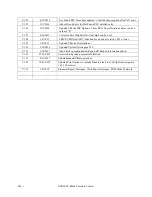
314 •
SPS-300 P-Mode Password Control
Gallonage
To simplify gasoline transactions, PLU’s can be designated to calculate gallons sold on fuel
purchases. The price of the fuel sold is entered as it would be in a normal “open” PLU.
However the price per gallon of fuel is entered where the PLU preset price is normally
maintained. When fuel is sold, the register will refer to the programmed price per gallon and
calculate the number of gallons sold. Both the gallons pumped and dollar amount of the gas
purchase are conveniently printed on the customer receipt and sales journal. This provides all
the necessary information for a customer that needs a receipt for gas purchases. The total of
gallons sold is also maintained on the appropriate PLU report, in the place of the PLU item
counter. Several gallonage PLU’s could be placed on the keyboard to maintain records for
different pumps, or types of fuel. Thus, the dollar and gallon totals can provide a useful security
check against separate pump totals.
Groups (PLU Groups)
Groups are used to organize sets of items. For example, in a restaurant Grill Items, Drinks, and
Ice Cream items might be separated into different groups. Up to 99 group totals are available.
Group reporting is available on the group report.
HALO
The high amount lock-out (HALO) limits the amount allowed to be entered in a PLU, or
function key.
HASH
Merchants often sell non-merchandise items, such as lottery tickets, or bottle deposits, that they
do not wish to account for as reportable revenue. HASH PLU’s are useful to account for non-
revenue income. They will add to the appropriate totals on the PLU report, they will add to the
transaction totals, and they will be accountable for in drawer totals, but they will not affect the
merchants, NET SALES, GROSS SALES or NON-RESETTABLE GRAND TOTAL. As a
system option, HASH can be defined to not add to the transaction (NON-ADD).
Link (PLU Link)
Use linked PLU’s if you wish the registration a PLU to automatically cause the registration of
another PLU (for example to automatically add a bottle deposit.) Linked PLU’s are set with
Program 350, PLU Link programming.
Macro
Macro keys may be programmed to record, and then later perform, up to 50 keystrokes.
For example, a macro key could be set to tender (preset tender) a common currency, such as $5
into the cash key.
Memory Allocation
Memory allocation is a program that determines how the system memory is divided to provide
the correct features for your application. For example, you may require more or less clerk
memory, PLU’s, or electronic journal memory. Memory allocation allows you to maximize the
features you need while minimizing the features you do not need.
Mix & Match
Retailers often offer discounts when multiples of different items are purchased. For example, the







































